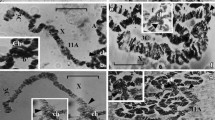Abstract
Three suppressor loci for position-effect variegation, one dominant temperature-sensitive (DTS), three Minute genes, and two recessive visible mutants (ed, tkv) have been cytogenetically localized by using duplicatons and deficiencies in regions 23–25 of chromosome arm 2L of Drosophila melanogaster. Two of the suppressor loci studied proved to represent haplo-abnormal genes localized in regions 23A6-23F6 and 24E2-25A1, respectively. The third one is a strong triplo-abnormal suppressor mapping in 25F4-26B9 which affects white variegation in w m4h when present in three doses. The l(2)2 DTS mutation, which belongs to a group of noncomplementing dominant temperature-sensitive mutations, is localized in the 25A4-B1 region. Furthermore, two Minute genes have been localized in region 24 that are included in Df (2L)M11 and can be separated employing translocation (Y;2)P8 (24E2–4): M(2)LS2 in 24D3-4-24E2-4, and M(2)z in 24E4-5-24F5-7. A third Minute gene (M(2)S1) is localized in 25C3-8-25C9-D1. The usefulness of the isolated chromosomal rearrangements for further genetic studies of region 23–26 is discussed.
Similar content being viewed by others
References
Bridges PN (1942) A new map of the salivary gland 2L chromosome of Drosophila melanogaster. J Hered 33:403–408
Ephrussi B, Herold JL (1944) Studies of eye pigments of Drosophila. I. Methods of extraction and quantitative estimation of the pigment components. Genetics 29:148–175
Grace D (1980) Genetic analysis of the dumpy complex locus in Drosophila melanogaster: Complementation, fine structure and function. Genetics 94:647–662
Grell EH (1969) Induction of duplications of genes which specify enzymes in Drosophila melanogaster. Genetics 61:423
Henikoff S (1979) Position-effects and variegation enhancers in an autosomal region of Drosophila melanogaster. Genetics 93:105–115
Holden JJ, Ashburner M (1978) Patterns of puffing activity in the salivary gland chromosomes of Drosophila. IX. The salivary and prothoracic gland chromosomes of dominant temperature-sensitive lethal of D. melanogaster. Chromosoma 68:205–227
Keppy DO, Denell RE (1979) A mutational analysis of the triplo-lethal region of Drosophila melanogaster. Genetics 91:421–441
Lindsley DL, Grell EN (1968) Genetic variations of Drosophila melanogaster. Carnegie Inst., Wash Publ No 627
Lindsley DL, Sandler L, Baker BS, Carpenter ATC, Denell RE, Hall JC, Jacobs PA, Miklos GIG, Davis BK, Getheann RC, Hardy RW, Hessler A, Miller SM, Nozawa H, Parry DM, Gould-Somero M (1972) Segmental aneuploidy and the genetic gross structure of the Drosophila genome. Genetics 71:157–184
Reuter G, Wolff I (1981) Isolation of dominant suppressor mutations for position-effect variegation in Drosophila melanogaster. Mol Gen Genet 182:516–519
Reuter G, Werner W, Hoffmann HJ (1982) Mutants affecting position-effect heterochromatinization in Drosophila melanogaster. Chromosoma 85:539–551
Reuter G, Hoffmann HJ, Wolff I (1983) Genetic study of position-effect variegation in Drosophila melanogaster: In(1)w m4 as a standard rearrangement for the isolation and characterization of suppressor and enhancer mutants. Biol Zbl 102:281–298
Saura AO (1980) Electron microscopic analysis of the banding pattern in the salivary gland chromosomes of Drosophila melanogaster: Divisions 23 through 26 of 2L. Hereditas 93:295–309
Suzuki DT, Procunier D (1969) Temperaturesensitive mutations in Drosophila melanogaster. III. Dominant lethals and semi-lethals on chromosome 2. Proc Natl Acad Sci 62:369–376
Velissariou V, Ashburner M (1980) The secretory proteins of the larval salivary gland of Drosophila melanogaster. Cytogenetic correlation of a protein and a puff. Chromosoma 77:13–27
Author information
Authors and Affiliations
Rights and permissions
About this article
Cite this article
Reuter, G., Szidonya, J. Cytogenetic analysis of variegation suppressors and a dominant temperature-sensitive lethal in region 23–26 of chromosome 2L in Drosophila melanogaster . Chromosoma 88, 277–285 (1983). https://doi.org/10.1007/BF00292904
Received:
Revised:
Issue Date:
DOI: https://doi.org/10.1007/BF00292904



